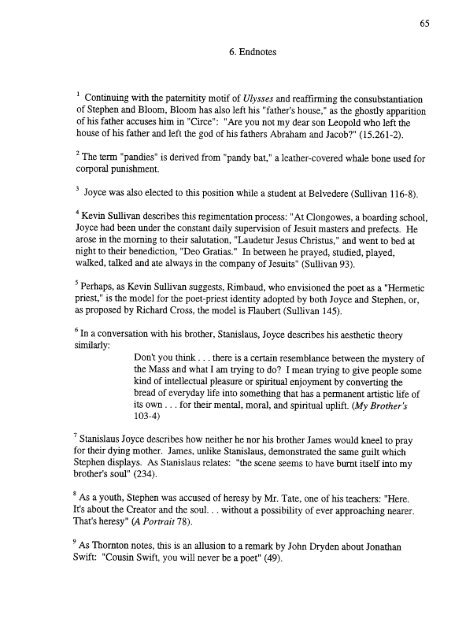Faubourg Saint Patrice - ScholarsArchive at Oregon State University
Faubourg Saint Patrice - ScholarsArchive at Oregon State University
Faubourg Saint Patrice - ScholarsArchive at Oregon State University
You also want an ePaper? Increase the reach of your titles
YUMPU automatically turns print PDFs into web optimized ePapers that Google loves.
6. Endnotes<br />
Continuing with the p<strong>at</strong>ernitity motif of Ulysses and reaffirming the consubstanti<strong>at</strong>ion<br />
of Stephen and Bloom, Bloom has also left his "f<strong>at</strong>her's house," as the ghostly apparition<br />
of his f<strong>at</strong>her accuses him in "Circe": "Are you not my dear son Leopold who left the<br />
house of his f<strong>at</strong>her and left the god of his f<strong>at</strong>hers Abraham and Jacob?" (15.261-2).<br />
2 The term "pandies" is derived from "pandy b<strong>at</strong>," a le<strong>at</strong>her-covered whale bone used for<br />
corporal punishment.<br />
3 Joyce was also elected to this position while a student <strong>at</strong> Belvedere (Sullivan 116-8).<br />
4 Kevin Sullivan describes this regiment<strong>at</strong>ion process: "At Clongowes, a boarding school,<br />
Joyce had been under the constant daily supervision of Jesuit masters and prefects. He<br />
arose in the morning to their salut<strong>at</strong>ion, "Laudetur Jesus Christus," and went to bed <strong>at</strong><br />
night to their benediction, "Deo Gr<strong>at</strong>ias." In between he prayed, studied, played,<br />
walked, talked and <strong>at</strong>e always in the company of Jesuits" (Sullivan 93).<br />
5<br />
Perhaps, as Kevin Sullivan suggests, Rimbaud, who envisioned the poet as a "Hermetic<br />
priest," is the model for the poet-priest identity adopted by both Joyce and Stephen, or,<br />
as proposed by Richard Cross, the model is Flaubert (Sullivan 145).<br />
6 In a convers<strong>at</strong>ion with his brother, Stanislaus, Joyce describes his aesthetic theory<br />
similarly:<br />
Don't you think . . . there is a certain resemblance between the mystery of<br />
the Mass and wh<strong>at</strong> I am trying to do? I mean trying to give people some<br />
kind of intellectual pleasure or spiritual enjoyment by converting the<br />
bread of everyday life into something th<strong>at</strong> has a permanent artistic life of<br />
its own . . . for their mental, moral, and spiritual uplift. (My Brother's<br />
103-4)<br />
Stanislaus Joyce describes how neither he nor his brother James would kneel to pray<br />
for their dying mother. James, unlike Stanislaus, demonstr<strong>at</strong>ed the same guilt which<br />
Stephen displays. As Stanislaus rel<strong>at</strong>es: "the scene seems to have burnt itself into my<br />
brother's soul" (234).<br />
8<br />
As a youth, Stephen was accused of heresy by Mr. T<strong>at</strong>e, one of his teachers: "Here.<br />
It's about the Cre<strong>at</strong>or and the soul. . without a possibility of ever approaching nearer.<br />
Th<strong>at</strong>'s heresy" (A Portrait 78).<br />
9 As Thornton notes, this is an allusion to a remark by John Dryden about Jon<strong>at</strong>han<br />
Swift: "Cousin Swift, you will never be a poet" (49).<br />
65















